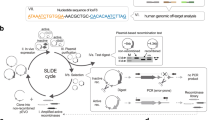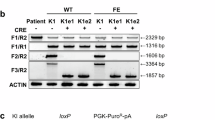Abstract
The intron 22 inversion found in up to 50% of severe hemophilia A patients results from a recombination between three intron 22 homologous copies (int22h). This study evaluated the implication of these copies in the formation of extended duplications comprising exons 1–22 of the factor 8 (F8) gene and their association with hemophilia and mental retardation. Two hemophilic patients with moderate and severe phenotypes and a third nonhemophilic patient with developmental delay were studied. All exhibited a duplication of F8 gene exons 1–22 identified by multiplex ligation-dependent probe amplification along with abnormal patterns on Southern blotting and unexpected long-range PCR amplification. Breakpoint analysis using array comparative genomic hybridization was performed to delimit the extent of these rearrangements. These duplications were bounded on one side by the F8 intragenic int22h-1 repeat and on the other side by extragenic int22h-2 or int22h-3 copies. However, the simultaneous identification of a second duplication containing F8 gene exons 2–14 for the moderate patient and the classical intron 22 inversion for the severe patient are considered in this study as the genetic causal defects of hemophilia. This study shows that the well-known int22h copies are involved in extended duplications comprising F8 gene exons 1–22. These specific duplications are probably not responsible for hemophilia and intellectual disability, but should be carefully considered in genetic counseling, while continuing to investigate the causal mutation of hemophilia.
Similar content being viewed by others
Log in or create a free account to read this content
Gain free access to this article, as well as selected content from this journal and more on nature.com
or
References
Lakich D, Kazazian HH, Antonarakis DE, Gitschier J : Inversions disrupting the factor VIII gene are a common cause of hemophilia A. Nat Genet 1993; 5: 236–241.
Naylor JA, Brinke A, Hassock S, Green PM, Giannelli F : Characteristic mRNA abnormality found in half the patients with severe hemophilia A is due to large DNA inversion. Hum Mol Genet 1993; 2: 1773–1778.
Antonarakis SE, The international consortium study: Factor VIII gene inversions in severe hemophilia A: results of an international consortium study. Blood 1995; 86: 2206–2212.
Bagnall RD, Waseem N, Green PM, Giannelli F : Recurrent inversion breaking intron 1 of the factor VIII gene is a frequent cause of severe haemophilia A. Blood 2002; 99: 168–174.
Oldenburg J, Ananyeva NM, Saenko EL : Molecular basis of haemophilia A. Haemophilia 2004; 10 (Suppl 4): 133–139.
Bogdanova N, Markoff A, Pollmann H et al: Spectrum of molecular defects and mutation detection rate in patients with severe hemophilia. Hum Mutat 2005; 26: 249–254.
Rost S, Löffler S, Pavlova A, Müller CR, Oldenburg J : Detection of large duplications within the factor VIII gene by MLPA. J Thromb Haemost 2008; 6: 1996–1999.
Lannoy N, Abinet I, Dahan K, Hermans C : Identification of de novo deletion in the factor VIII gene by MLPA technique in two girls with isolated factor VIII deficiency. Haemophilia 2009; 15: 797–801.
Acquila M, Pasino M, Lanza T, Bottini F, Molinari AC, Bicocchi MP : Duplication of exon 13 causes one third of the cases of mild hemophilia A in northern Italy. Haematologica 2004; 89: 758–759.
Zimmermann MA, Oldenburg J, Müller CR, Rost S : Characterization of duplication breakpoints in the factor VIII gene. J Thromb Haemost 2010; 8: 2696–2704.
Lannoy N, Abinet I, Bosmans A, Lambert C, Vermylen C, Hermans C : Computational and molecular approaches for predicting unreported causal missence mutations in Belgian patients with haemophilia A. Haemophilia 2012; 18: e331–e339.
Miller SA, Dykes DD, Polesky HF : A simple salting out procedure for extracting DNA from human nucleated cells. Nucleic Acids Res 1988; 16: 1215.
Bagnall RD, Giannelli F, Green PM : Int22h-related inversions causing hemophilia A: a novel insight into their origin and a new more discriminant PCR test for their detection. J Thromb Haemost 2006; 4: 591–598.
Van der Luijt R, Poppe B, De Smet E et al: Rapid detection of VHL exon deletions using real-time quantitative PCR. J Lab Invest 2005; 85: 24–33.
Kutsche K, Ressler B, Katzera HG et al: Characterization of breakpoint sequences of five rearrangements in L1CAM and ABCD1 (ALD) genes. Hum Mutat 2002; 19: 526–535.
Bauters M, Van Esch H, Friez MJ et al: Nonrecurrent MECP2 duplications mediated by genomic architecture-driven DNA breaks and break-induced replication repair. Genome Res 2008; 18: 847–858.
Ross MT, Grafham DV, Coffey AJ et al: The DNA sequence of the human X chromosome. Nature 2005; 5: 236–241.
De Brasi CD, Bowen DJ : Molecular characteristics of the intron 22 homologs of the coagulation factor VIII gene: an update. J Thromb Haemost 2008; 6: 1822–1824.
Bagnall RD, Giannelli F, Green PM : Polymorphism and hemophilia A causing inversions in distal Xq28: a complex picture. J Thromb Haemost 2005; 3: 2598–2599.
Green P, Hill M, Bowen DJ, UK Haemophilia Centre Doctors’ Organisation Haemophilia Genetics Network: Duplications involving int22h-1 of the factor VIII gene: a cause for concern in genetic testing for hemophilia A? Thromb Haemost 2007; 5: 2155–2156.
El-Hattab AW, Fang P, Jin W et al: Int22h-1/int22h-2-mediated Xq28 rearrangements: intellectual disability associated with duplications and in utero male lethality with deletions. J Med Genet 2011; 48: 840–850.
Hu XY, Burghes AH, Ray PN, Thompson MW, Murphy EG, Worton RG : Partial gene duplication in Duchenne and Becker muscular dystrophies. J Med Genet 1988; 25: 369–376.
Murru S, Casula L, Pecorara M, Mori P, Cao A, Pirastu M : Illegitimate recombination produced a duplication within the FVIII gene in a patient with mild hemophilia A. Genomics 1990; 7: 115–1158.
Allen RC, Zoghbi HY, Moseley AB, Rosenblatt HM, Belmont JW : Methylation of HpaII and HhaI sites near the polymorphic CAG repeat in the human Androgen-receptor gene correlates with X chromosome inactivation. Am J Hum Genet 1999; 51: 1229–1239.
Sharp A, Robinson D, Jacobs P : Age-and tissue-specific variation of X chromosome inactivation ratios in normal women. Hum Genet 2000; 107: 343–349.
Giannandrea M, Bianchi V, Mignogna ML et al: Mutations in the small GTPase gene RAB39B are responsible for X-linked mental retardation associated with autism, epilepsy, and macrocephaly. Am J Hum Genet 2010; 86: 185–195.
Pegoraro E, Whitaker J, Mowery-Rushton P, Surti U, Lanasa M, Hoffman EP : Familial skewed X inactivation: a molecular trait associated with high spontaneous abortion rate maps to Xq28. Am J Hum Genet 1997; 61: 160–170.
Koolen DA, Pfundt R, de Leeuw N et al: Genomic microarrays in mental retardation: a practical workflow for diagnostic applications. Hum Mutat 2009; 30: 283–292.
Andrikovics H, Klein I, Bors A et al: Analysis of large structural changes of the factor VIII gene, involving intron 1 and 22, in severe hemophilia A. Haematologica 2003; 88: 778–784.
Arruda VR, Pieneman WC, Reitsma PH et al: Eleven novel mutations in the factor VIII gene from Brazilian hemophilia A patients. Blood 1995; 86: 3015–3020.
Windsor S, Taylor SA, Lillicrap D : Direct detection of a common inversion mutation in the genetic diagnosis of severe hemophilia A. Blood 1994; 84: 2202–2205.
Zimmermann MA, Oldenburg J, Müller CR, Rost S : Unusual genomic rearrangements in introns 1 and 22 of the F8 gene. Hamostaseologie 2011; 31 (Suppl 1): S69–S73.
Yamazaki E, Mohri H, Inaba H, Harano H, Kanamori H, Okubo T : Variant of intron 22 inversions in the factor VIII gene in severe hemophilia A. Blood Coagul Fibrinolysis 1997; 8: 445–449.
Enayat MS, Theophilus BD, Williams MD, Hill FG : Another unique variant pattern of intron 22 rearrangement in factor Vlll gene seen in a hemophilia A family. Blood 1995; 85: 2639.
Rosslier JP, Young M, Kimberland ML et al: Factor VIII gene inversions causing severe hemophilia A originate almost exclusively in male germ cell. Hum Mol Genet 1994; 3: 1035–1039.
Acknowledgements
We are indebted to the subjects participating in this study and their families. We thank Mrs I Abinet, Mr A Bosmans, and Mr V Kayndaszyk for their expert technical assistance, and Mrs Pascale Hilbert for chromosome-X-inactivation analysis. These studies were partially supported by a grant from Bayer Schering Pharma.
Author information
Authors and Affiliations
Corresponding author
Ethics declarations
Competing interests
The authors declare no conflict of interest.
Rights and permissions
About this article
Cite this article
Lannoy, N., Grisart, B., Eeckhoudt, S. et al. Intron 22 homologous regions are implicated in exons 1–22 duplications of the F8 gene. Eur J Hum Genet 21, 970–976 (2013). https://doi.org/10.1038/ejhg.2012.275
Received:
Revised:
Accepted:
Published:
Issue date:
DOI: https://doi.org/10.1038/ejhg.2012.275
Keywords
This article is cited by
-
Clinical characterization of int22h1/int22h2-mediated Xq28 duplication/deletion: new cases and literature review
BMC Medical Genetics (2015)



